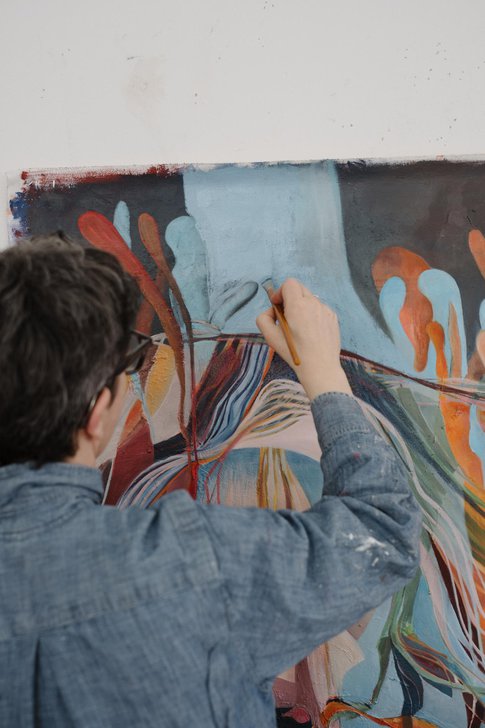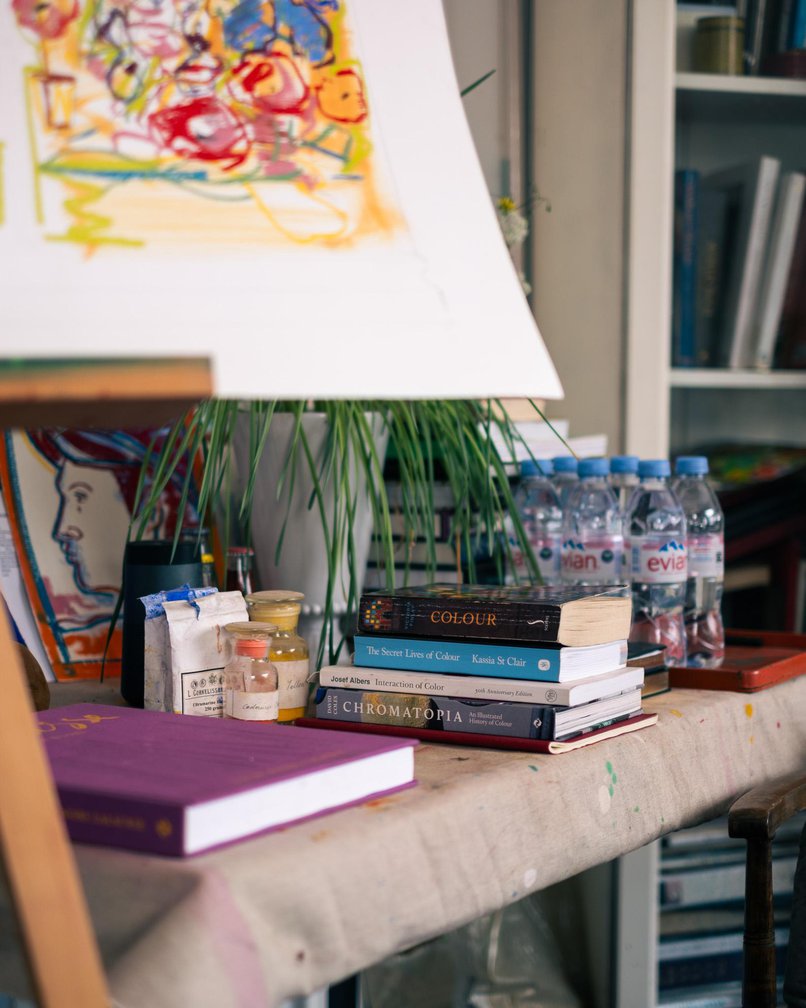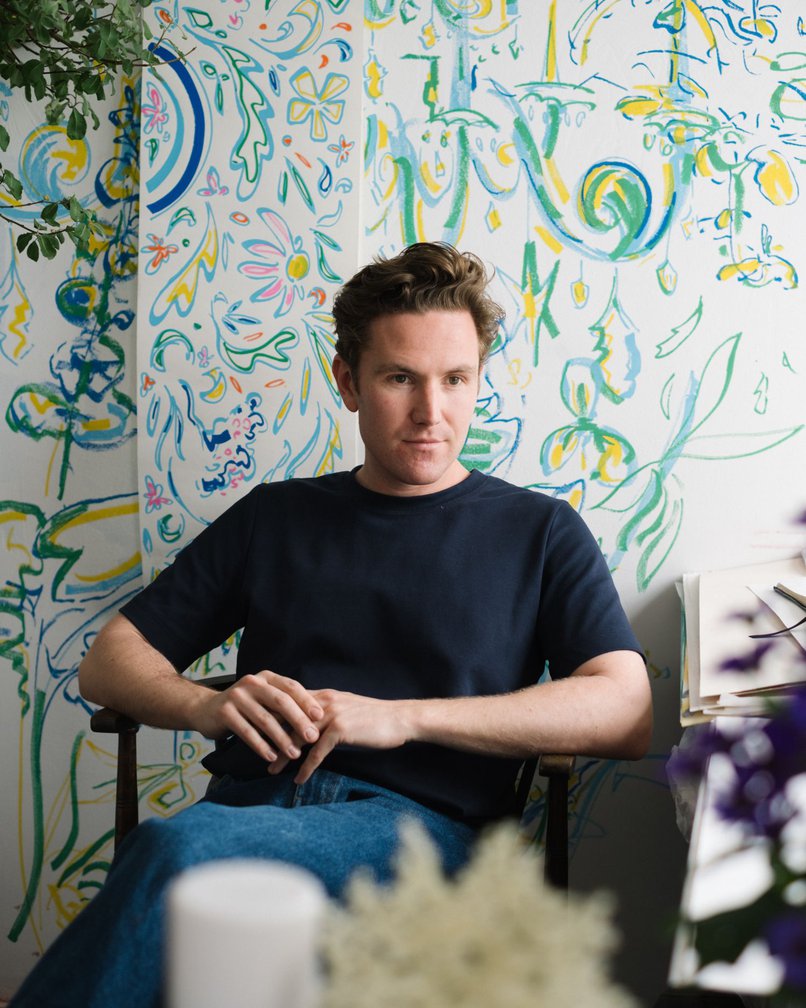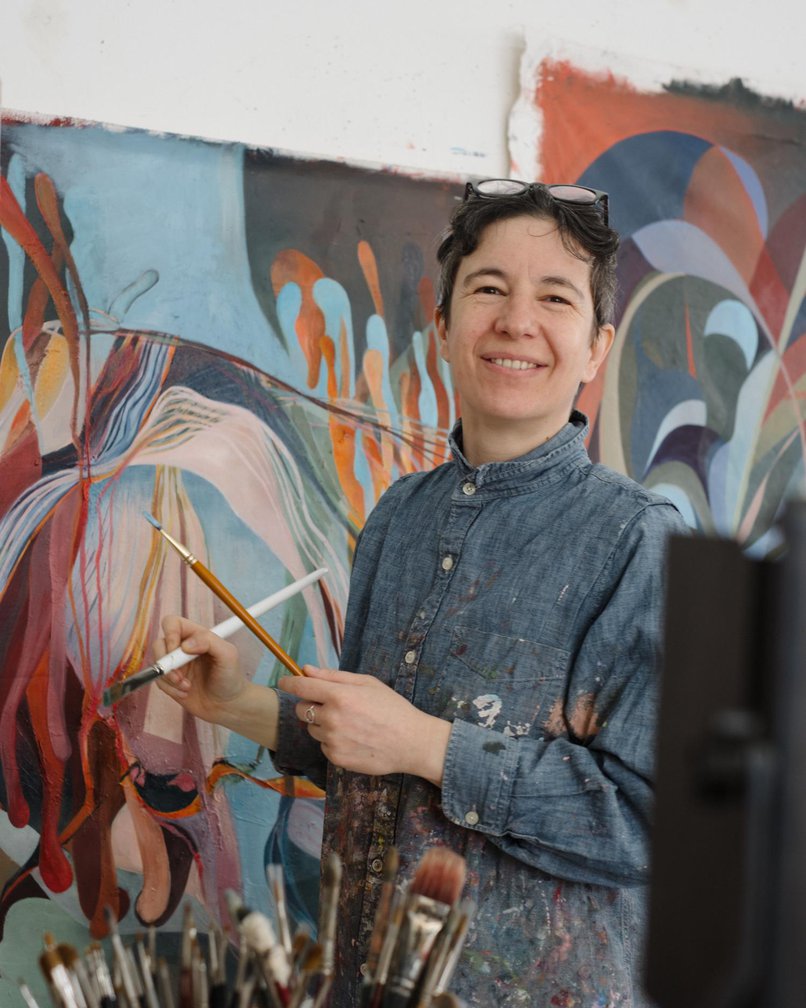article Queer Colours
Queer Colours

In honour of Pride Month, we're exploring
what colour means to four queer artists
living and working in London today.
what colour means to four queer artists
living and working in London today.
In honour of Pride Month, we're exploring
what colour means to four queer artists
living and working in London today.

Throughout art history, the voices of minority artists have challenged conventional narratives and broadened our understanding of the human experience. Yet, behind the scenes of this creative expression exists a complex web of expectation and pressure. Within this, minority artists must navigate the line between authentic self-expression and the societal demand to create work that evidences their experience.
For many queer artists, success may feel contingent on their ability to translate, visualise, and express what it means to be a minority. But queer art does not necessarily need to reference the queer experience; queer art can be any artwork made by a queer artist, regardless of its subject matter.
This pride month, we are celebrating queer art in all its forms. From collage to oil paints, murals to weaving, we’ve spoken with four queer artists about their complex, varied, and liberating relationships with colour.
The relationship between queer expression and colour is well-documented. The Six-Color Pride Flag, created by gay rights activist Gilbert Baker in 1978, is one of the most well-known LGBT flags in history. Updated by Valentino Vecchietti to represent a wider variety of queer communities, the modern Progress Pride Flag now includes a spectrum of 11 different colours that recognize intersex, trans, and people of colour within the LGBTQ+ community, as well as those living with HIV/AIDS.
Meanwhile, queer artists such as David Hockney, Ellsworth Kelly and Marie Laurencin are celebrated within the art historical canon for their accomplished use of colour. They have broken ground for modern contemporaries like Nicole Eisenman, Salman Toor, and Sin Wai Kin, who continue to create vibrant works that resonate with audiences beyond the artists' queer identity.
This month, and every month, we are working towards a more inclusive arts industry that champions diversity and supports artists with fair and equal access to pay and opportunity. It has been a pleasure to meet with Sam, Maria, Jacob and Sophie and we are excited to share with you their multicoloured stories.
For many queer artists, success may feel contingent on their ability to translate, visualise, and express what it means to be a minority. But queer art does not necessarily need to reference the queer experience; queer art can be any artwork made by a queer artist, regardless of its subject matter.
This pride month, we are celebrating queer art in all its forms. From collage to oil paints, murals to weaving, we’ve spoken with four queer artists about their complex, varied, and liberating relationships with colour.
The relationship between queer expression and colour is well-documented. The Six-Color Pride Flag, created by gay rights activist Gilbert Baker in 1978, is one of the most well-known LGBT flags in history. Updated by Valentino Vecchietti to represent a wider variety of queer communities, the modern Progress Pride Flag now includes a spectrum of 11 different colours that recognize intersex, trans, and people of colour within the LGBTQ+ community, as well as those living with HIV/AIDS.
Meanwhile, queer artists such as David Hockney, Ellsworth Kelly and Marie Laurencin are celebrated within the art historical canon for their accomplished use of colour. They have broken ground for modern contemporaries like Nicole Eisenman, Salman Toor, and Sin Wai Kin, who continue to create vibrant works that resonate with audiences beyond the artists' queer identity.
This month, and every month, we are working towards a more inclusive arts industry that champions diversity and supports artists with fair and equal access to pay and opportunity. It has been a pleasure to meet with Sam, Maria, Jacob and Sophie and we are excited to share with you their multicoloured stories.
Maria Calliste
Maria Calliste is a mixed-media artist currently in her final year at Central St Martins. Using digital and physical collage, she creates textured, colourful paintings that transform her feelings and experiences into fictional narratives. These storylines typically explore the relationship between people and their surroundings.
Inspired by ‘Décollage’, Maria’s work draws from an extensive material archive. From cinema tickets to peels of old graffiti, her work repurposes surfaces to explore how objects and images can be manipulated to create dimension, depth, and contrast. This playful approach to making extends into Maria’s relationship with colour.
Sometimes her work is directed by a specific colour theme, other times she works intuitively, combining a variety of influences to create bright, engaging compositions that “float into the figures in her work”. By doing so Maria uses colour to ‘protect’ her figures and explore her identity without pressure and expectation.
Maria Calliste is a mixed-media artist currently in her final year at Central St Martins. Using digital and physical collage, she creates textured, colourful paintings that transform her feelings and experiences into fictional narratives. These storylines typically explore the relationship between people and their surroundings.
Inspired by ‘Décollage’, Maria’s work draws from an extensive material archive. From cinema tickets to peels of old graffiti, her work repurposes surfaces to explore how objects and images can be manipulated to create dimension, depth, and contrast. This playful approach to making extends into Maria’s relationship with colour.
Sometimes her work is directed by a specific colour theme, other times she works intuitively, combining a variety of influences to create bright, engaging compositions that “float into the figures in her work”. By doing so Maria uses colour to ‘protect’ her figures and explore her identity without pressure and expectation.

Sam Wood
Sam Wood is a muralist, painter and illustrative artist based in London. His relaxed, gestural style is rooted in modernist drawing practices and includes a variety of floral and architectural motifs. Born in Gloucestershire, he uses bold lines and vivid colours to translate the landscapes of his rural upbringing and explores how these early scenes intertwine with the urban environment in which he now resides.
From fashion brands to interior design houses, Sam’s work interacts with a variety of stakeholders. His early experiences working for a design studio significantly influenced his practice and allowed him to recognise the seriousness of colour.
Passionate about its ability to engage and impact a variety of people Sam advises: “You don’t have to be too serious about colour, but it performs a serious purpose.”
Sam Wood is a muralist, painter and illustrative artist based in London. His relaxed, gestural style is rooted in modernist drawing practices and includes a variety of floral and architectural motifs. Born in Gloucestershire, he uses bold lines and vivid colours to translate the landscapes of his rural upbringing and explores how these early scenes intertwine with the urban environment in which he now resides.
From fashion brands to interior design houses, Sam’s work interacts with a variety of stakeholders. His early experiences working for a design studio significantly influenced his practice and allowed him to recognise the seriousness of colour.
Passionate about its ability to engage and impact a variety of people Sam advises: “You don’t have to be too serious about colour, but it performs a serious purpose.”

Sophie Anne Wyth
Sophie Anne Wyth is a French-Swiss oil painter based in East London. After an extensive career in fashion, she rediscovered her passion for art through art therapy, an encounter that reminded Sophie of the value of the creative act over the final product.
Sophie’s work explores the ephemeral nature of happiness and equilibrium. Grateful for their impermanence, her use of colour and composition celebrates the fleeting and ever-changing balance of life. Her choice of colour is similarly informed. Both deliberate and instinctive, she is driven by an obsession that makes each piece unique and dynamic.
Sophie's paintings require viewers to engage deeply, finding harmony in unexpected combinations. She thrives on the unpredictability of her creations, stating: “If I know how it’s going to look in the end, I’m not interested." Her abstract work, rooted in intuition, reflects her life philosophy that happiness must be continually reassessed and recreated, mirroring her journey of self-discovery and evolving desires.
Sophie Anne Wyth is a French-Swiss oil painter based in East London. After an extensive career in fashion, she rediscovered her passion for art through art therapy, an encounter that reminded Sophie of the value of the creative act over the final product.
Sophie’s work explores the ephemeral nature of happiness and equilibrium. Grateful for their impermanence, her use of colour and composition celebrates the fleeting and ever-changing balance of life. Her choice of colour is similarly informed. Both deliberate and instinctive, she is driven by an obsession that makes each piece unique and dynamic.
Sophie's paintings require viewers to engage deeply, finding harmony in unexpected combinations. She thrives on the unpredictability of her creations, stating: “If I know how it’s going to look in the end, I’m not interested." Her abstract work, rooted in intuition, reflects her life philosophy that happiness must be continually reassessed and recreated, mirroring her journey of self-discovery and evolving desires.

Jacob Monk
Jacob Monk is a hand weaver and textile artist based in South London. His practice uses the ancient technique of Ikat – an Indonesian dyeing process in which patterns are created by binding and dyeing yarns before weaving.
Inspired by bird feathers and tropical plants, his vibrant colour palettes and modern compositions are revitalizing this traditional technique with a contemporary twist.
Jacob uses a variety of materials including viscose, silk, and paper thread, combining Ikat with other dip dyeing methods to create dynamic, gradient patterns. To Jacob, “there is no wrong way of using colour, or no wrong colour combination”.
While the meticulousness of weaving can deter others from the medium, Jacob’s love for its slow, careful nature has allowed him to transform single threads into intricate fabrics. Currently, Jacob is collecting bird feathers to embellish his textiles, aiming to create more tactile, three-dimensional pieces. Passionate about handcraft, he continually pushes the boundaries of his skills and techniques.
Jacob Monk is a hand weaver and textile artist based in South London. His practice uses the ancient technique of Ikat – an Indonesian dyeing process in which patterns are created by binding and dyeing yarns before weaving.
Inspired by bird feathers and tropical plants, his vibrant colour palettes and modern compositions are revitalizing this traditional technique with a contemporary twist.
Jacob uses a variety of materials including viscose, silk, and paper thread, combining Ikat with other dip dyeing methods to create dynamic, gradient patterns. To Jacob, “there is no wrong way of using colour, or no wrong colour combination”.
While the meticulousness of weaving can deter others from the medium, Jacob’s love for its slow, careful nature has allowed him to transform single threads into intricate fabrics. Currently, Jacob is collecting bird feathers to embellish his textiles, aiming to create more tactile, three-dimensional pieces. Passionate about handcraft, he continually pushes the boundaries of his skills and techniques.

Keep an eye on our Instagram throughout Pride Month for more content with Sam, Maria, Jacob and Sophie!
By Riki Auton, Marketing Executive at Artiq
By Riki Auton, Marketing Executive at Artiq